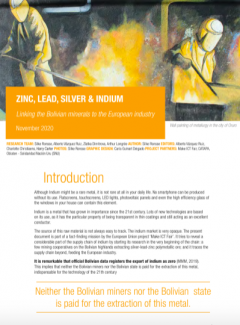Linking the Bolivian Minerals to the European Industry
Project partners were Make ICT Fair, CATAPA and Oblaten - Solidaridad Nación Uru (SNU). Published in November 2020.

From the introduction:
Although indium might be a rare metal, it is not rare at all in your daily life. No smartphone can be produced without its use. Flatscreens, touchscreens, LED lights, photovoltaic panels and even the high efficiency glass of the windows in your house can contain this element.
Indium is a metal that has grown in importance since the 21st century. Lots of new technologies are based on its use, as it has the particular property of being transparent in thin coatings and still acting as an excellent conductor. The source of this raw material is not always easy to track. The indium market is very opaque.
[The report] is part of a fact-finding mission by the European Union project ‘Make ICT Fair’. It tries to reveal a considerable part of the supply chain of indium by starting its research in the very beginning of the chain: a few mining cooperatives on the Bolivian highlands extracting silver-lead-zinc polymetallic ore; and it traces the supply chain beyond, feeding the European industry.
Disclaimer: This project is organised with the financial assistance of the European Union. The contents of this web page is the sole responsibility of the University of Edinburgh and can under no circumstances be regarded as reflecting the position of the European Union.
Some of the research reports shared on this website have been produced by the University of Edinburgh's partners on the EU-funded Make ICT Fair project. These reports do not reflect the views of the University of Edinburgh, and any queries regarding their content should be addressed to the authors identified within each report.

